龍,與文明共生,與歷史同游,與中國同興,是智慧、力量、剛健、威嚴的象征。北京歷史底蘊深厚,棲居著不少享譽中外的龍。在甲辰龍年,又怎能錯過“與龍共舞”的機會?不妨讓我們環繞獨有壯美的中軸線、漫游時尚現代的文旅新地標、徜徉如黛青山和瀲滟水光,打卡十個有“龍”出沒的景點地標吧!
The Chinese Dragon, or “loong”, embodies wisdom, strength, vitality, and dignity. It has been an integral part of Chinese civilization since ancient times, flourishing alongside the nation’s development and growth. Beijing, with its rich historical heritage, is renowned for its many dragons celebrated both within China and internationally. During the Year of the Dragon, you won’t want to miss the chance to encounter these mythical creatures. Join us on a tour along Beijing’s distinctive and majestic central axis, where we will uncover trendy cultural and tourism spots, wander through verdant mountains and glistening waters, and explore ten landmarks where “dragons” are said to roam!
1.北海公園:九龍壁上究竟有多少龍?
Beihai Park: How many dragons can you count on the Nine-Dragon Wall?
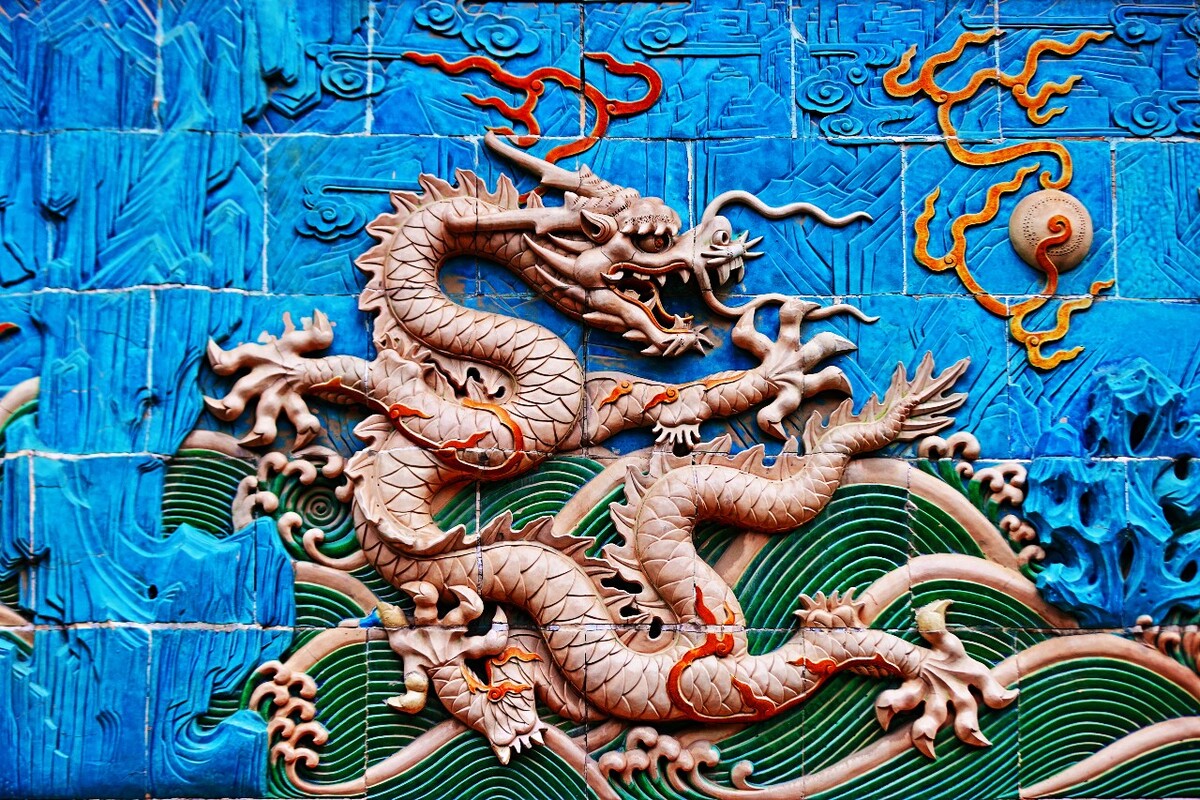
九龍壁 Nine-Dragon Wall
北京中軸線以西,坐落著中國現存建園最早、保存最完整的皇家園林——北海公園,擁有中國唯一一座雙面九龍壁。九龍壁兩面各有九條蟠龍,或從海面騰空而起,或從空中俯身下躍,飛騰戲珠于波濤云際之中,栩栩如生,氣勢非凡。
To the west of Beijing’s central axis lies Beihai Park, China’s oldest and most well-preserved imperial garden. It is home to the country’s only double-sided Nine-Dragon Wall. Each side of the wall is adorned with nine coiling dragons, either soaring from the sea or diving from the sky, engaging in a playful dance with a pearl amidst waves and clouds. They are depicted with lifelike vividness and a powerful presence.
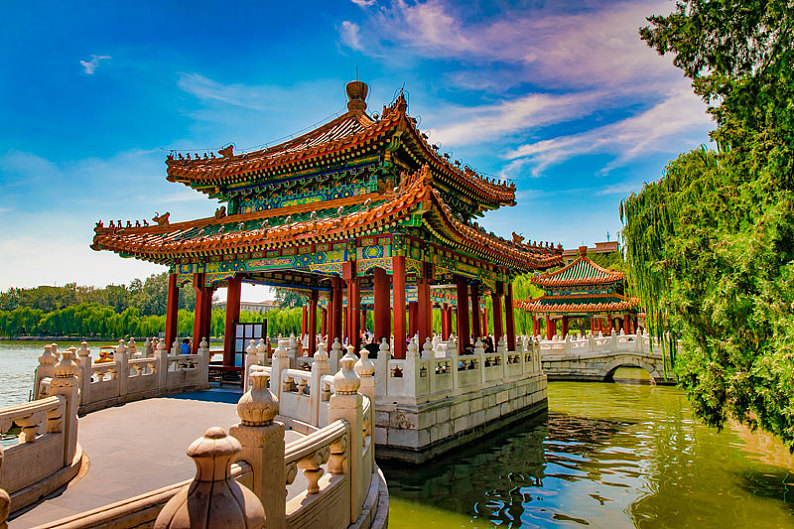
五龍亭 Five Dragon Pavilions
北海公園九龍壁之西即闡福寺,寺前即五龍亭。五個亭子由石橋與白玉石欄桿相連,錯落有致地跨在水面之上,宛如巨龍,故稱其為“龍亭”。
To the west of the Nine-Dragon Wall in Beihai Park is the Chanfu Temple, and in front of the temple are the Five Dragon Pavilions. The five pavilions are interconnected by stone bridges and white marble railings, elegantly arrayed across the water’s surface, resembling a giant dragon, hence their name “Dragon Pavilions”.
2.故宮:世界上含龍量最高的地方
The Forbidden City: The place in the world with the highest concentration of Chinese Dragons

故宮角樓 Turret of the Forbidden City

太和殿 Hall of Supreme Harmony
漫步至北京中軸線中心,故宮可能是世界上擁有龍最多的一處地方!以紫禁城規格最高、最重要的大殿——太和殿為例,就約有13000多只形態各異龍騰飛于殿宇之間。從黃色琉璃瓦的屋頂看去,有生性喜歡吞火的螭吻(龍吻)作為辟火神獸駐扎在屋脊之上,密布于木質結構的金龍在陽光下流光溢彩、美輪美奐,下雨時底座之上的龍形螭首會呈現“千龍吐水”的奇觀……可謂是從上至下,從金至石都布滿了龍的存在。
As you stroll towards the heart of Beijing’s central axis, the Forbidden City may well be the place in the world with the highest concentration of Chinese dragons! Take, for example, the Hall of Supreme Harmony, the most important and grandest hall in the Forbidden City, which is home to over 13,000 soaring dragons. Gazing at the yellow glazed-tile roofs, you will spot the chiwen (a mythical creature with a dragon head and a fish body)—known for its love of devouring fire—perched atop the ridges. The golden dragons adorning the wooden structures shimmer and glow in the sunlight, presenting a dazzling spectacle. When it rains, the dragon-shaped chiwen atop the bases create the marvel of “a thousand dragons spitting out water”. It is clear that from the highest point to the lowest, and from the gilded details to the stonework, the presence of dragons is pervasive.
3.頤和園:龍得巢乃棲于此
The Summer Palace: A haven for dragons to dwell
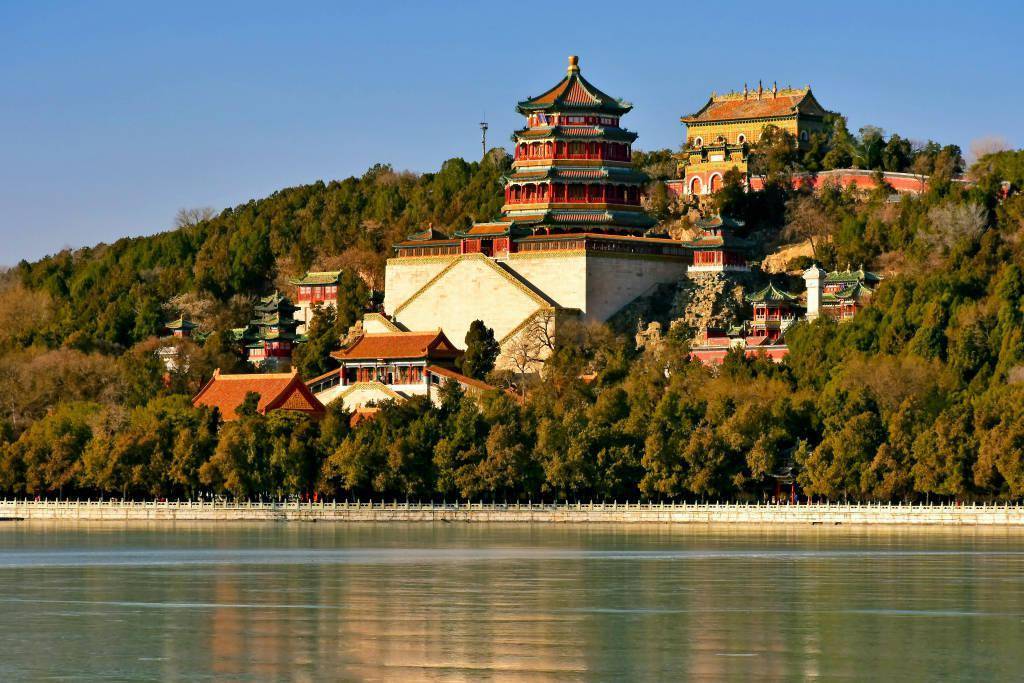
頤和園 The Summer Palace
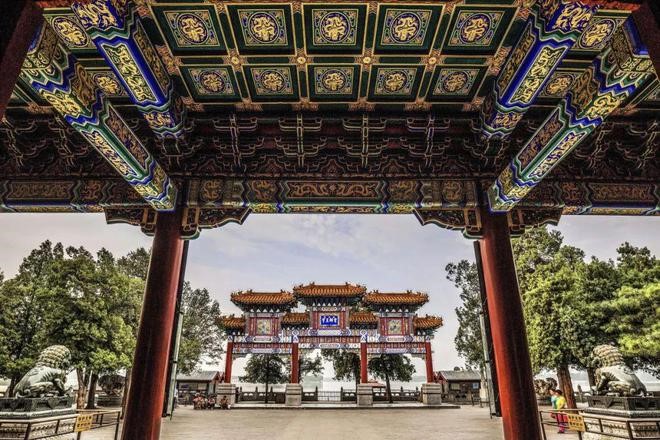
龍紋和璽彩畫 Dragon motifs and multicolored paintings
天一生水,地六成之,是靈氣匯聚之地。古時認為,頤和園位于北京的乾位,臨近玉泉山,園內有亭臺樓閣石橋連接大地,正合天地之數,龍最有可能在此棲居。乾隆二十年,乾隆皇帝在頤和園廣潤祠祈雨,當晚甘霖從天而降。除了頗具神秘色彩的傳說,東宮門的井字團龍天花、繪金龍和璽彩畫,頤和園內排云殿、佛香閣建筑群的龍鳳雕版、龍紋石刻等龍元素為“尋龍”更添趣味。
The Summer Palace is a sanctuary where the vital forces of heaven and earth meet. It is thought to be situated in the Qian (Heavenly) position of Beijing, close to Yuquanshan (lit. Jade Spring Hill). The park’s pavilions, towers, and stone bridges, which symbolically connect to the earth, are in harmony with the cosmic patterns, making it a favored dwelling for dragons. During the 20th year of Emperor Qianlong’s reign (1755), he sought rain at the Guangrun Shrine within the Summer Palace. And that very night, a beneficial downpour answered his prayers. Beyond this enigmatic tale, the East Gate of the Summer Palace boasts a ceiling pattern with coiling dragons, while the golden dragons and imperial seals painted on the halls add to the charm of the “dragon-seeking” tour. Moreover, the intricate dragon and phoenix carvings and stone carvings with dragon patterns at the Hall of Dispelling Clouds (Paiyun Dian) and the Tower of the Fragrance of the Buddha (Foxiang Ge) complex within the Summer Palace deepen the tour’s enjoyment.
4.天壇:福運連連,龍行昌順
The Temple of Heaven: A journey of fortune along the propitious dragon

祈年殿 The Temple of Heaven
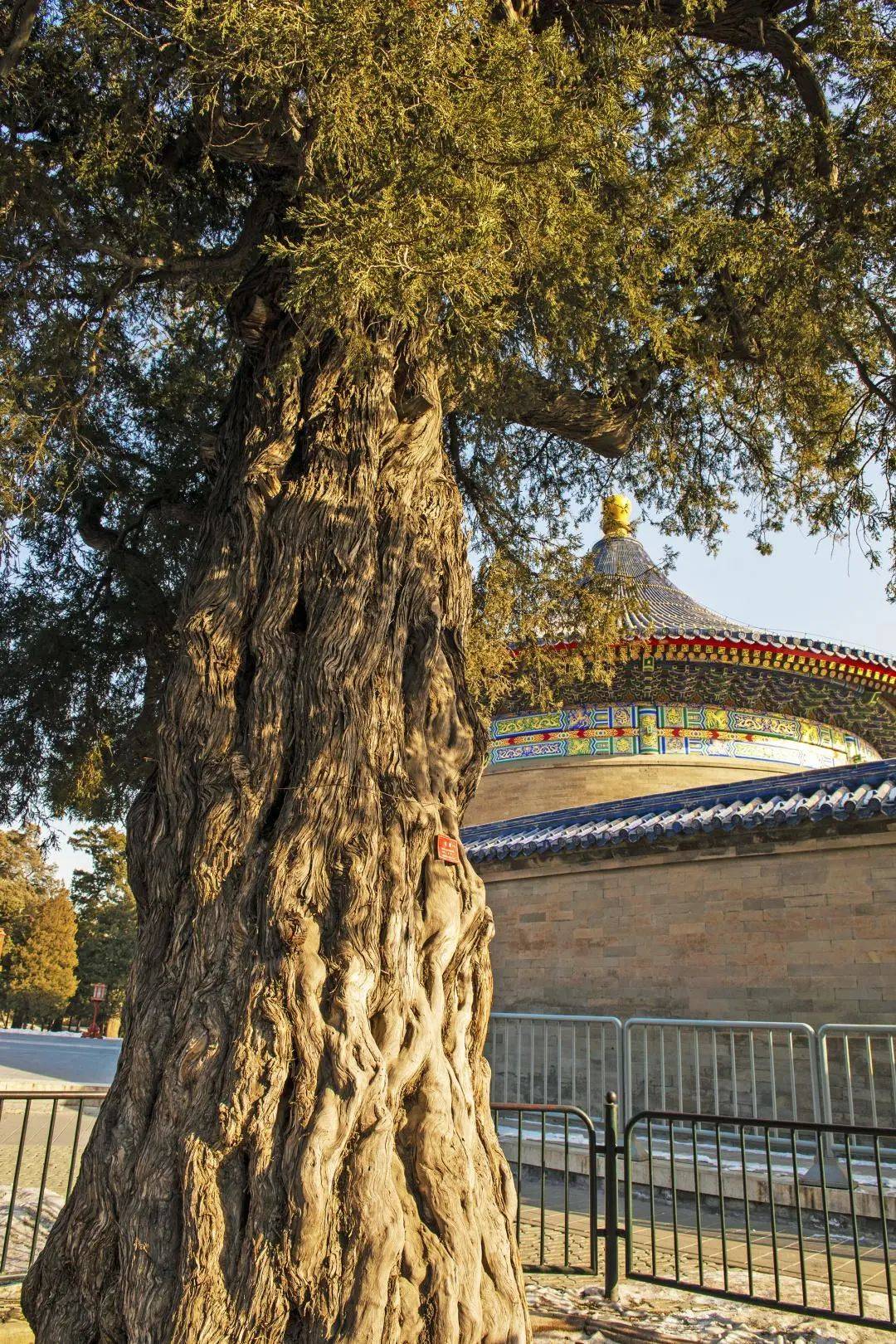
九龍柏 Nine-dragon Cypress
天壇是世界上現存最大的古代祭天建筑群,承載著中國古人天圓地方、敬畏自然的宇宙觀,人與天在此溝通對話。作為王權天賜的象征,其中必然有大量的龍元素存在。
The Temple of Heaven stands as the largest extant ancient complex dedicated to celestial sacrifices, reflecting the ancient Chinese cosmological view of a round heaven and a square earth, and a reverence for nature where dialogue between humans and the celestial happens. As a symbol of divinely ordained imperial rule, it is replete with dragon imagery.
祈年殿的天花板是精致的九龍藻井,與之相應的平面圓形大理石面上是自然形成的龍鳳花紋,叫龍鳳石。在皇穹宇西墻外,有一棵歷經五百余年風雨的古樹。青針翠葉、虬枝銅柯,仿佛九條龍在云端飛舞,因此得名“九龍柏”。
The Hall of Prayer for Good Harvests is embellished with a magnificent nine-dragon domed ceiling, while the corresponding flat circular marble floor boasts naturally occurring dragon and phoenix patterns, known as the Dragon-Phoenix Stone. Beyond the west wall of the Imperial Vault of Heaven stands an ancient tree that has braved the elements for more than five centuries. Its verdant needles, rich foliage, gnarled branches, and robust bark mimic nine dragons cavorting amidst the clouds, giving it the moniker “Nine-Dragon Cypress”.
5.香山公園:龍深山色,共“香”盛舉
Xiangshan Park (Fragrant Hills): Where dragons roam in the heart of the mountains

香山公園 Xiangshan Park
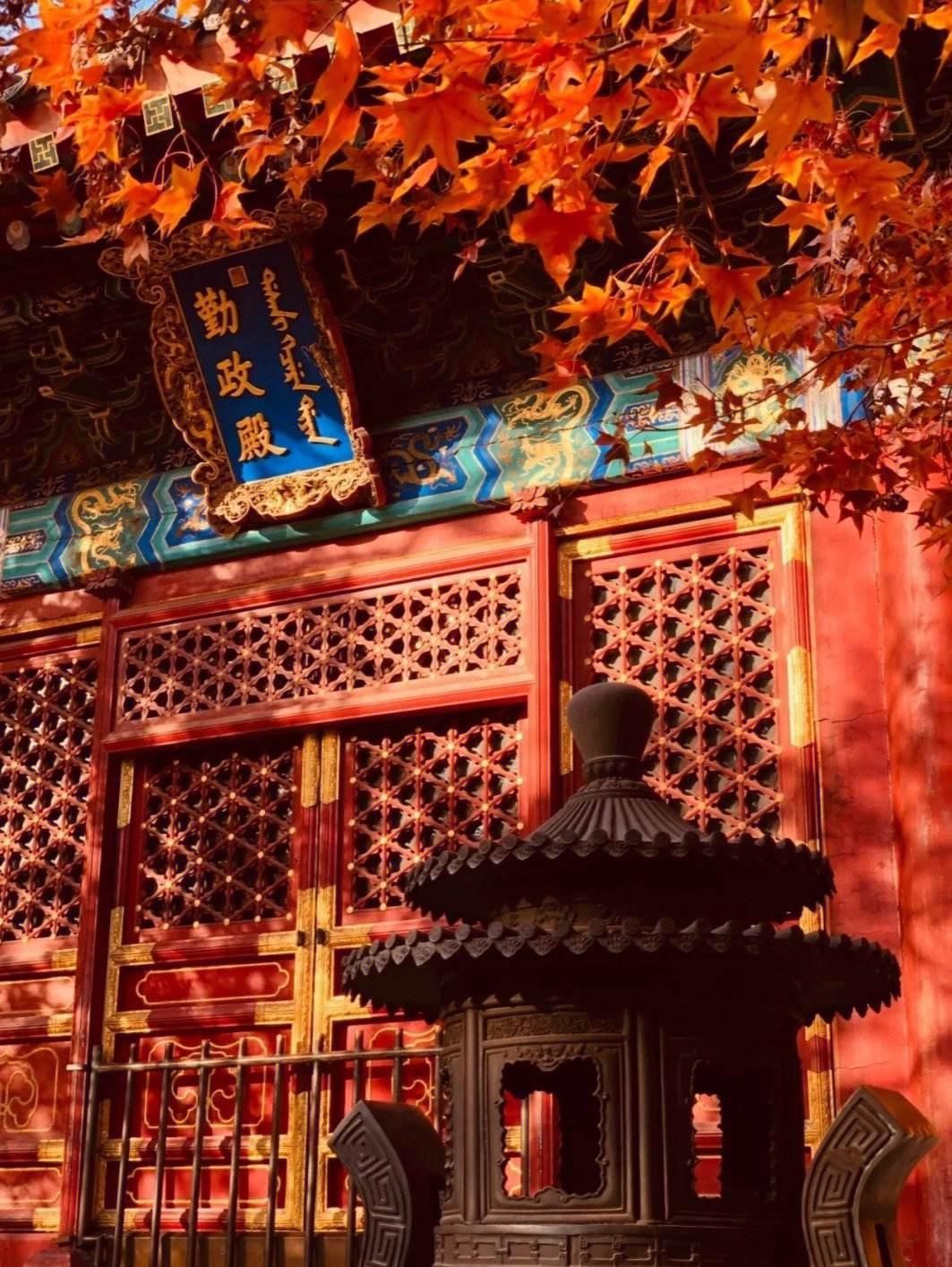
勤政殿 Qinzheng Hall
勤政殿為香山二十八景之首,是清代皇帝在香山靜宜園駐蹕期間,處理朝政和接見王公大臣的場所。大殿彩畫采用金龍和璽,殿內匾額、屏風、五屏金漆龍椅、蟠龍香筒和香爐等,均遍布龍紋龍飾。隨處可見的龍元素,彰顯著皇家園林的恢弘氣勢。
Xiangshan Park is home to Qinzheng Hall, which is the first of the twenty-eight scenic spots of Xiangshan. It was where Qing Dynasty emperors managed state affairs and met with princes and ministers while staying at Jingyi Garden in Xiangshan. The hall is adorned with colorful paintings featuring golden dragons and imperial seals. Inside, dragon motifs are prominently displayed on plaques, screens, the five-panel golden lacquered dragon throne, coiling dragon incense burners, and censers, underscoring the garden’s imperial majesty.
在香山半山的昭廟之中,彩色琉璃坊和碑亭均飾有龍紋圖案、雕刻等,金碧輝煌,生動精美。依山勢迭起的香山寺,無論是彩畫,還是雕刻,或者建筑零部件等,常有龍形,精致秀美。
At the Zhaomiao Temple, situated midway up Xiangshan, the colorful glazed tile archway and stele pavilion are embellished with dragon patterns and carvings, radiating a resplendent and vivid beauty. The Xiangshan Temple, nestled amidst the mountain’s rolling landscapes, is abundant with dragon motifs in its paintings, carvings, and architectural elements, highlighting the temple’s fine and graceful artisanship.
6.什剎海:水不在深,有龍則靈
Shichahai: Where dragons dwell, even shallow waters gain spirit

什剎海 Shichahai
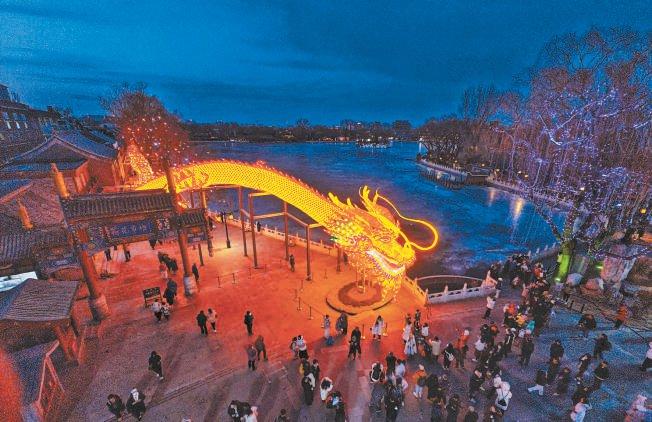
巨型龍燈 The giant dragon lantern
什剎海是北京內城一處具有開闊水面的開放型景區,也是北京城內面積最大、風貌保存最完整的一片歷史街區,毗鄰北京城中軸線。在什剎海展出著一盞名為“蛟龍出海”的巨型龍燈,全長202.4米,寓意“2024龍騰四海”。它巧妙地將傳統彩燈藝術與現代科技光效相結合,造型霸氣,尤其是金紅色龍頭上的長須飄逸,栩栩如生。
Shichahai is an open scenic area in downtown Beijing with a wide expanse of water, and it is the largest and most well-preserved historical block in the city, adjacent to Beijing’s central axis. Displayed at Shichahai is a massive dragon lantern named “Jiaolong Chuhai” (lit. “The Dragon Emerges from the Sea”), which is 202.4 meters long, with the auspicious meaning of “dragons soaring over the four seas in 2024”. It skillfully combines traditional colored lantern art with modern lighting technology, showcasing a majestic appearance, especially the long, flowing whiskers on the golden and red dragon head, which are incredibly lifelike.
7.國家雪車雪橇中心:游龍在天,翱翔九霄
The National Sliding Center: Dragon soaring to the ninth heavens
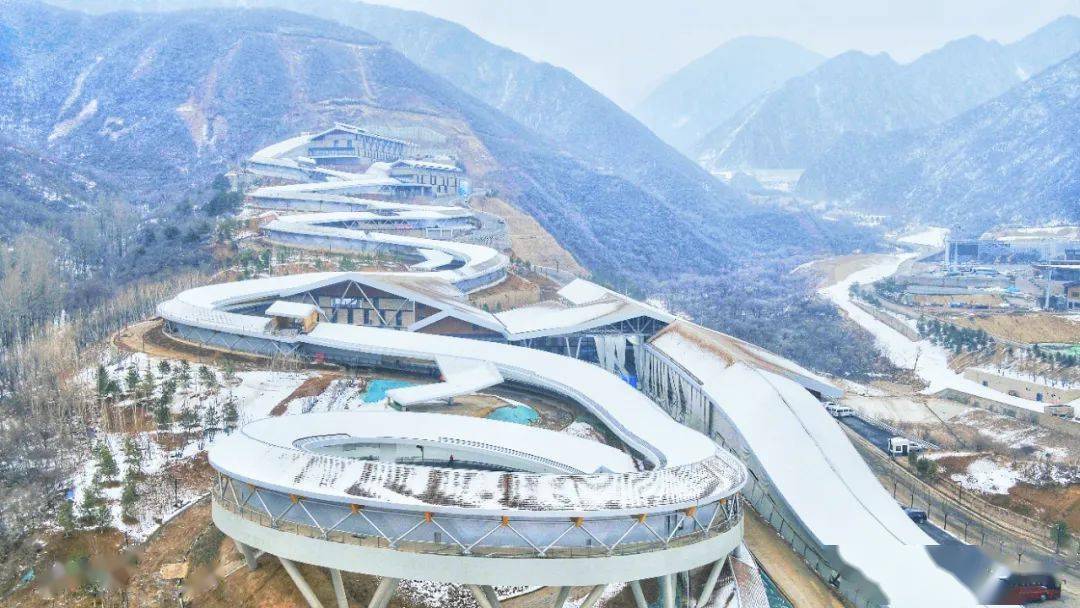

被稱為“雪游龍”的國家雪車雪橇中心
The National Sliding Center (known as the “Snow Dragon”
國家雪車雪橇中心是中國國內第一條、也是唯一一條符合冬奧會標準的雪車雪橇賽道,在2022年北京冬奧會期間承擔了雪車、鋼架雪車和雪橇三個項目的全部比賽。賽道全長1975米,高差121米,依山就勢,如臥龍一樣盤踞在山脊之上。“雪游龍”的設計靈感來源于中國傳統文化元素“如意”,寓意吉祥如意。
The National Sliding Center is the first and only bobsleigh and luge track in China that meets Olympic Winter Games standards. During the 2022 Beijing Winter Olympics, it hosted all the bobsleigh, skeleton, and luge events. The track measures 1,975 meters in length with a vertical drop of 121 meters, winding through the mountains in a serpentine fashion, resembling a crouching dragon coiled along the ridge. The design of the “Snow Dragon” draws inspiration from the traditional Chinese cultural element “Ruyi”, symbolizing good fortune and prosperity.
8.天安門:“望君歸”與“望君出”
Tian’anmen: “Wang Jun Gui” and “Wang Jun Chu”

天安門城樓 Tian’anmen Gate Tower

天安門華表上的龍 Dragons on the ornamental columns of Tian’anmen
天安門坐落于首都北京中軸線和長安街的交匯點,是明清兩朝皇城正門。天安門前后各有一對漢白玉的柱子,稱作華表或“望柱”,上有石犼(蹬龍)蹲立,柱身雕刻云龍。面向宮外的石犼叫“望君歸”,意為盼望皇帝外出游玩不要久久不歸,應快回宮料理國事;面向宮內的石犼叫“望君出”,勸戒皇帝不要老待在宮內尋歡作樂,應常到宮外去了解百姓的苦難。它們和天安門前的石獅以及兩側的金水橋一起烘托著北京這座皇城的威嚴氣勢。
Tian’anmen is located at the intersection of Beijing’s central axis and Chang’an Avenue, serving as the main gate of the imperial city during the Ming (1368-1644) and Qing (1644-1912) dynasties. In front of and behind Tian’anmen stand pairs of marble columns known as huabiao, or “watching columns”, each crowned with a stone creature known as a denglong, or stone hound, which appears to be crouching. These columns are adorned with intricate cloud dragon carvings along their lengths. The stone hounds that face outward are named “Wang Jun Gui”, a term that expresses the hope for the emperor’s safe return. They represent the wish that when the emperor journeyed outside the palace, he would not tarry but would instead hasten his return to attend to the affairs of the state. Conversely, the stone hounds that face inward are known as “Wang Jun Chu”, symbolizing the hope that the emperor would venture forth from the palace. This serves as a gentle reminder for the emperor to venture beyond the palace walls and connect with his people, understanding their hardships. In concert with the stone lions that guard the entrance to Tian’anmen and the Golden Water Bridges that span either side, these elements contribute to the stately grandeur of Beijing as the capital of China, reflecting its rich history and cultural significance.
9.中國考古博物館:龍文化主題文物展之“最”
Chinese Archaeological Museum: The pinnacle of Chinese dragon culture themed artifact exhibition
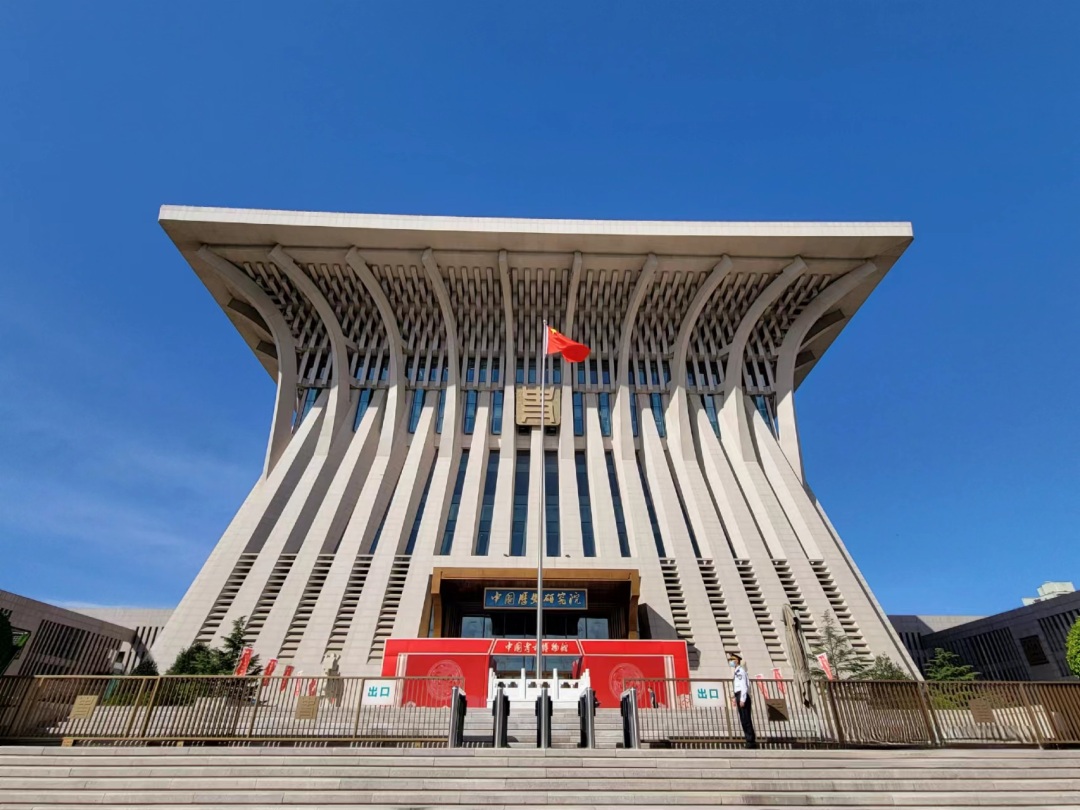
中國考古博物館 Chinese Archaeological Museum

二里頭遺址綠松石龍形器 Turquoise dragon-form artifact from Erlitou site
中國考古博物館地處北京奧林匹克公園核心區,以考古出土文物和珍貴古籍文獻為依托,打造北京城市中軸線上的歷史文化客廳和展示中華文明的國家窗口。
The Chinese Archaeological Museum is strategically located in the heart of the Beijing Olympic Park. It serves as a historical and cultural meeting place on Beijing’s central axis and as a national window showcasing the civilization of China, drawing on a collection of archaeological treasures and invaluable ancient texts.
2024年,中國考古博物館聯合22家考古文博單位共同推出“龍·中華民族的圖騰——中國八千年龍文化精品文物展”。其中展出的二里頭文化的杰出代表——綠松石龍形器,由2000余片各種形狀的細小綠松石組成,形象生動,色彩絢麗。其用工之巨、制作之精、體量之大在我國早期龍形象文物中十分罕見,是中國龍形象演化進程的關鍵節點。
In 2024, the Chinese Archaeological Museum, in collaboration with 22 archaeological and cultural heritage institutions, launched the “Dragon: The Totem of the Chinese Nation – An Exquisite Collection of 8,000 Years of Chinese Dragon Culture” exhibition. Among the exhibits, the outstanding representative of the Erlitou culture – the Turquoise dragon-form artifact – stands out. It is composed of over 2,000 pieces of variously shaped small turquoise stones, vivid in appearance and brilliant in color. The immense effort invested in its making, the exquisite craftsmanship, and its impressive size are rare among early dragon image artifacts in China, signifying a significant milestone in the evolutionary trajectory of the Chinese dragon imagery.
10.北京市海外文化交流中心文化空間:一展匯集現代生肖龍藝術
Cultural Space of Beijing Overseas Cultural Exchange Center (BOCEC): A collection of modern zodiac dragon art
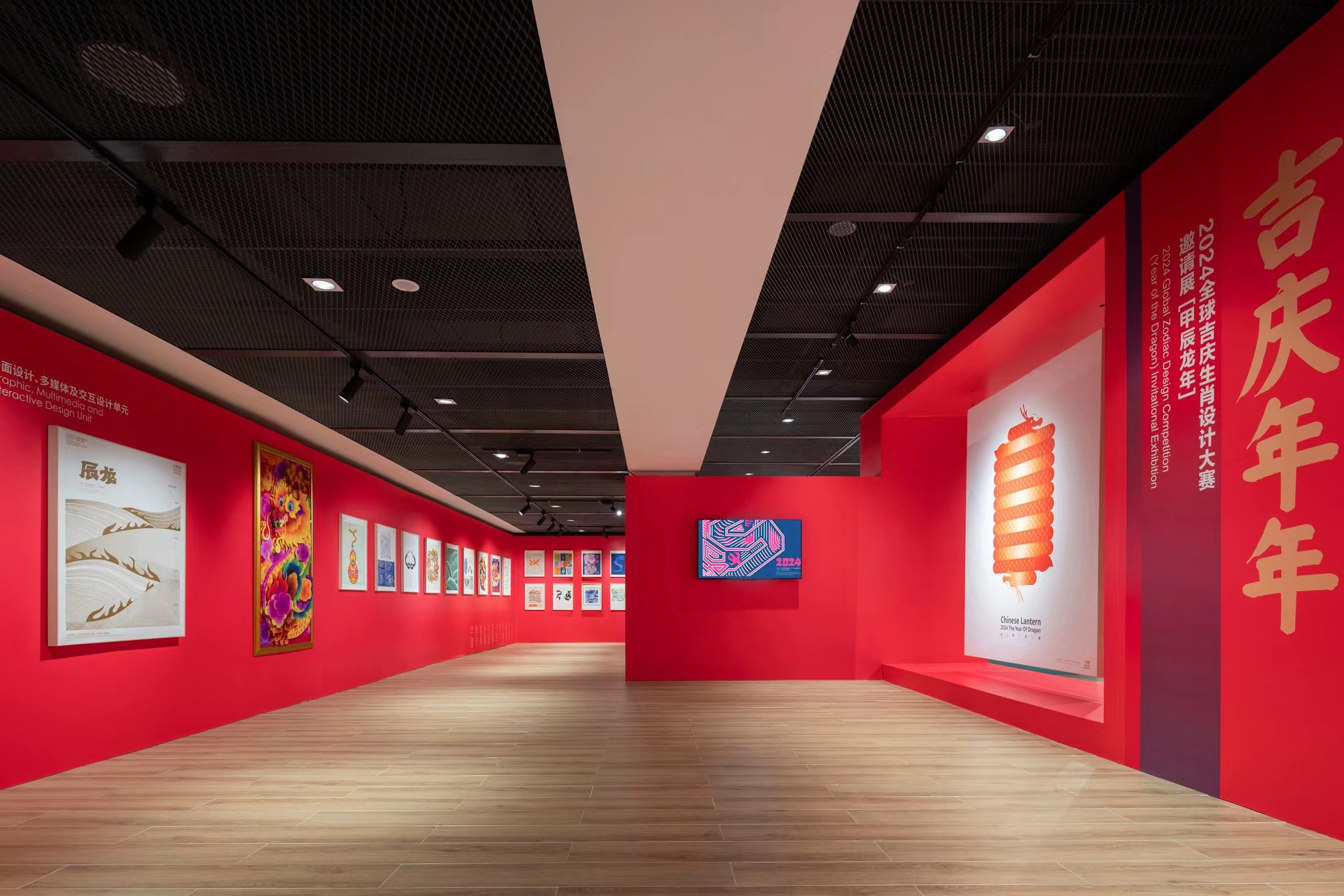

吉慶年年—全球吉慶生肖設計大賽邀請展(甲辰龍年)
正在北京市海外文化交流中心文化空間展出
Year In Year Out: Global Zodiac Design Competition Invitational Exhibition
(Year of the Dragon) now on display at the Cultural Space of BOCEC
在東長安街,有一個值得探尋、體驗的綜合性國際文化、旅游交流空間——北京市海外文化交流中心。該中心是北京市文化和旅游局所屬的事業單位,是北京市綜合性對外文化交流及港澳臺文化交流的專業機構。
Located on East Chang’an Street, the Beijing Overseas Cultural Exchange Center (BOCEC) is a comprehensive international space for cultural and tourism exchange that is worth exploring and experiencing. Affiliated with the Beijing Municipal Bureau of Culture and Tourism, the center is a professional institution dedicated to Beijing’s cultural exchanges with foreign countries and with Hong Kong, Macao, and Taiwan.
目前,“吉慶年年—全球吉慶生肖設計大賽邀請展(甲辰龍年)”正在空間展出,觀眾可以在現場欣賞到全球吉慶生肖設計大賽(甲辰龍年)和歷屆大賽的優秀生肖獲獎作品,以及韓美林、陳文令、申紅飆等國內藝術家以及墨西哥雕塑家塞巴斯蒂安、旅美華裔雕塑家吳信坤的生肖藝術作品。展覽將中國生肖龍與當代創新設計有機結合,以年輕化、時尚化、國際化的表達方式,彰顯中國生肖文化的深邃魅力。
The exhibition features outstanding zodiac award-winning works from the Global Zodiac Design Competition (Year of the Dragon) and its previous editions, as well as Chinese zodiac art pieces by renowned Chinese artists Han Meilin, Chen Wenling, Shen Hongbiao, and international artists including Mexican sculptor Sebastian and Chinese-American sculptor Wu Xinkun. The exhibition highlights the seamless fusion of the Chinese zodiac dragon with cutting-edge contemporary design, conveying the deep allure of Chinese zodiac culture in a vibrant, fashionable, and international manner.
龍年尋龍,歡迎大家來到北京這座“龍”味十足的城市,共赴一場誠意滿滿的“尋龍之旅”,領略北京獨具魅力的傳統文化!
In the Year of the Dragon, come to Beijing, a city steeped in “dragon” spirit, and embark on a thrilling “dragon-seeking tour” to delve into the city’s distinctive and enchanting traditional culture!